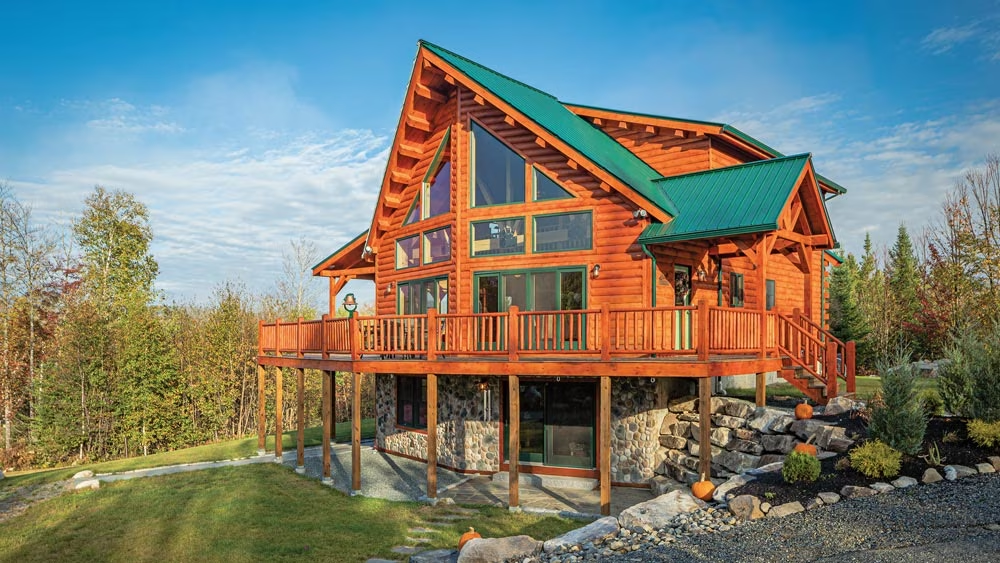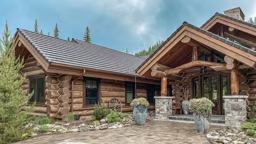For those new to the world of log and timber homes, there can be a bit of confusion. While most people can identify a log home at a glance, the subtle nuances, such as the style, the defining shape of the logs or how they come together as walls, remain a bit of a mystery.
And although timber framing (also known as post-and-beam) has a rich history that dates back far longer than log buildings do, today’s buyers often misidentify it as a form of log construction, since both use heavy wood components to comprise the load-bearing framework of their respective structures.
If it all feels a little foreign to you now, stress not. We’re about to break down the essential elements of each type — their similarities, differences and, in the articles to follow, the specific choices available to you as you shop for a log or timber home to call your own.
Logs are Historically Modern
For hundreds of years, log homes have been a symbol of the American frontier and have been associated with various presidents, most famously Abraham Lincoln. You’ll spot them in movies, on television shows and in advertisements, because any time a company wants to convey a feeling of history, quality or comfort, a log home fits the bill.
Full-log homes are made by stacking logs horizontally to form solid walls. But from there, there’s an array of choices that set them apart.
For starters, milled log homes have uniform sizes and shapes, whereas handcrafted logs vary in diameter and texture. Log styles, shapes and corner treatments also contribute to a log home’s look and performance and are a part of the decision-making process. Log home companies are happy to
walk you through the options.
Timeless Timber Frames
Timber frame homes are among the earliest permanent residences built in England’s American colonies, and they remained a dominant building method until the late 19th century when the development of balloon framing, which required little skill to build and answered the growing demand for mass housing, hit the scene.
Whereas log homes are comprised of horizontal logs stacked on top of each other, timber frames are post-and-beam homes, which employ a big-timber framework, akin to a skeleton, of upright posts supporting horizontal beams. This interlocking frame supports the load and transfers its weight to the foundation.
Timber framing is a specialized version of post-and-beam construction and relies heavily on handcraftsmanship to shape the timbers and fashion mortise-and-tenon joinery held in place with wooden pegs rather than metal fasteners. Embellishments to the frame include chamfering, pendants and other decorative carvings. The frame’s interlocking configuration eliminates the need for load-bearing interior walls, creating the wide-open living spaces today’s homeowners seek.
Timber home exteriors typically offer just a hint of the extensive woodwork inside. This allows them to easily fit in with nearby homes and subdivisions that enforce design covenants.
The Key Differences
Though log and timber homes are close cousins, the main distinction between them is how they use the wood. As a result, they achieve sharply different looks. And because timber homes can use a variety of exterior materials having nothing to do with the inside, they may not be recognizable as timber homes from the outside, whereas log homes are almost always easily spotted from the street.
The Similarities
For such remarkably different construction methods, timber and log homes do have a lot in common. Here are their most significant similarities:
- Both are custom homes, individually designed and produced with care and then built according to a precise building system.
- Both use big timbers (round or square) as their base, artfully fitted together to form a load-bearing structure.
- Both flourished in early America, then fell into relative obscurity until the mid-1970s, when log homes and timber framing experienced first a revival and then a boom that continues to this day.
- They share certain design conventions: open-concept layouts, cathedral ceilings, walls of windows, intricate roof trusses and soaring fireplaces.
- They both offer a variety of styles and design options.
- Both involve locations that are often rural, sometimes remote. Because these sites probably aren’t what you’re used to, it’s important to understand the logistics this kind of terrain can bring, such as developing your own infrastructure when it comes to water, electricity, sewage and even roads.
- The process of buying and building them is similar: Buy land. Design home. Prepare site. Build home. Furnish and landscape. Live your dream.
- Both are passion purchases: Totally discretionary buys that people make because they feel an emotional yearning to live in these kinds of homes.
- When built properly, both are highly energy efficient.
When it comes right down to it, most people choose a log or a timber home because they love the look and feel of a natural wood home. The quality of the building material or workmanship may play a significant role (certainly it affects the cost/value), but the unmatched beauty and the emotional element lie at the core of their popularity. Owning a log or timber-framed house is more than a roof over your head; it’s the embodiment of a lifestyle.













